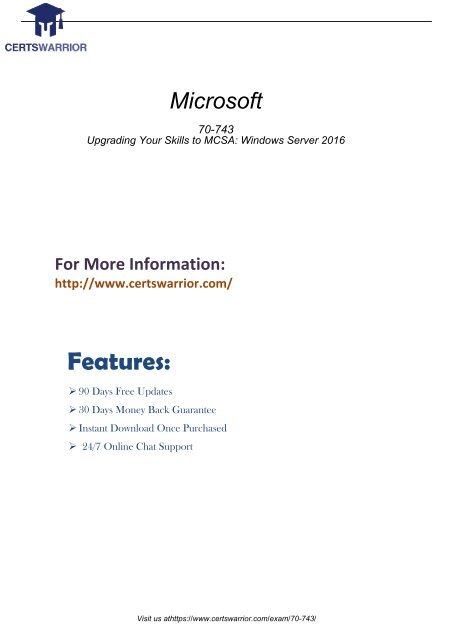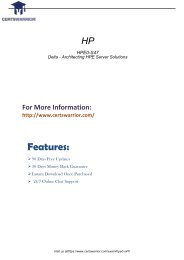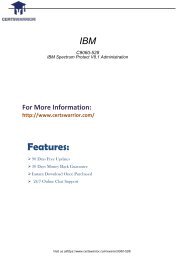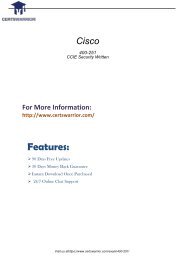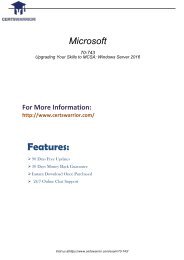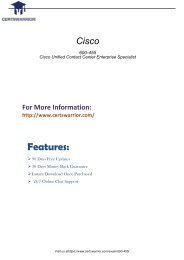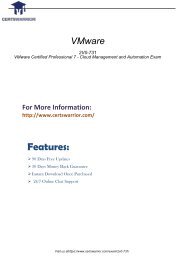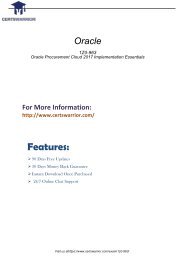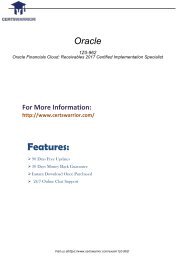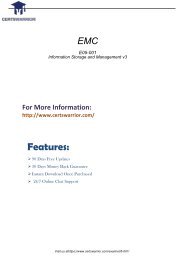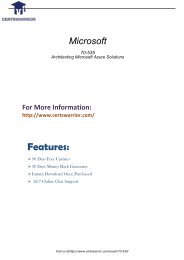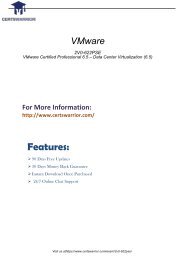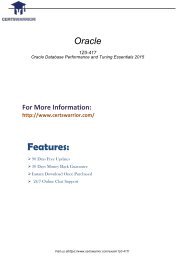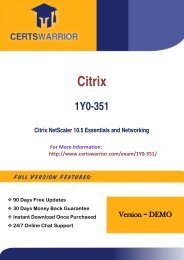70-743 Exam Practice Software
Get high success rate in 70-743 Certification Exam with our exam PDF questions answers prepared by the authorized persons of Information Technology industry. For more info please visit here: https://www.certswarrior.com/exam/70-743/
Get high success rate in 70-743 Certification Exam with our exam PDF questions answers prepared by the authorized persons of Information Technology industry. For more info please visit here: https://www.certswarrior.com/exam/70-743/
Create successful ePaper yourself
Turn your PDF publications into a flip-book with our unique Google optimized e-Paper software.
Microsoft<br />
<strong>70</strong>-<strong>743</strong><br />
Upgrading Your Skills to MCSA: Windows Server 2016<br />
For More Information:<br />
http://www.certswarrior.com/<br />
Features:<br />
‣ 90 Days Free Updates<br />
‣ 30 Days Money Back Guarantee<br />
‣ Instant Download Once Purchased<br />
‣ 24/7 Online Chat Support<br />
Visit us athttps://www.certswarrior.com/exam/<strong>70</strong>-<strong>743</strong>/
Question: 1<br />
Note: This question is part of a series of questions that present the same scenario. Each question in the<br />
series contains a unique solution that might meet the stated goals. Some questions sets might have<br />
more than one correct solutions, while others might not have a correct solution.<br />
After you answer a question in this section, you will NOT be able to return to it. As a result, these<br />
questions will not appear in the review screen.<br />
Your network contains an Active Directory forest named contoso.com. The forest contains a member<br />
server named Server1 that runs Windows Server 2016. All domain controllers run Windows Server 2012<br />
R2.<br />
Contoso.com has the following configuration:<br />
You plan to deploy an Active Directory Federation Services (AD FS) farm on Server1 and to configure<br />
device registration.<br />
You need to configure Active Directory to support the planned deployment.<br />
Solution: You upgrade a domain controller to Windows Server 2016.<br />
Does this meet the goal?<br />
A. Yes<br />
B. No<br />
Answer: B<br />
Explanation:<br />
Device registration requires a forest functional level of Windows Server 2012 R2.<br />
References:<br />
https://technet.microsoft.com/en-us/windows-server-docs/identity/ad-fs/deployment/configure-afederation-server-with-device-registration-service<br />
https://technet.microsoft.com/en-us/windows-server-docs/identity/ad-fs/design/ad-fs-requirements<br />
Question: 2<br />
Note: This question is part of a series of questions that present the same scenario. Each question in the<br />
series contains a unique solution that might meet the stated goals. Some questions sets might have<br />
more than one correct solutions, while others might not have a correct solution.<br />
Visit us athttps://www.certswarrior.com/exam/<strong>70</strong>-<strong>743</strong>/
After you answer a question in this section, you will NOT be able to return to it. As a result, these<br />
questions will not appear in the review screen.<br />
Your network contains an Active Directory forest named contoso.com. The forest contains a member<br />
server named Server1 that runs Windows Server 2016. All domain controllers run Windows Server 2012<br />
R2.<br />
Contoso.com has the following configuration:<br />
You plan to deploy an Active Directory Federation Services (AD FS) farm on Server1 and to configure<br />
device registration.<br />
You need to configure Active Directory to support the planned deployment.<br />
Solution: You raise the forest functional level to Windows Server 2012 R2.<br />
Does this meet the goal?<br />
A. Yes<br />
B. No<br />
Answer: B<br />
Explanation:<br />
For a Windows Server 2012 R2 AD FS server, this solution would work. However, new installations of AD<br />
FS 2016 require the Active Directory 2016 schema (minimum version 85).<br />
References:<br />
https://technet.microsoft.com/en-us/windows-server-docs/identity/adfs/operations/configure-device-based-conditional-access-on-premises<br />
Question: 3<br />
Note: This question is part of a series of questions that present the same scenario. Each question in the<br />
series contains a unique solution that might meet the stated goals. Some questions sets might have<br />
more than one correct solutions, while others might not have a correct solution.<br />
After you answer a question in this section, you will NOT be able to return to it. As a result, these<br />
questions will not appear in the review screen.<br />
Your network contains an Active Directory forest named contoso.com. The forest contains a member<br />
server named Server1 that runs Windows Server 2016. All domain controllers run Windows Server 2012<br />
R2.<br />
Contoso.com has the following configuration:<br />
Visit us athttps://www.certswarrior.com/exam/<strong>70</strong>-<strong>743</strong>/
You plan to deploy an Active Directory Federation Services (AD FS) farm on Server1 and to configure<br />
device registration.<br />
You need to configure Active Directory to support the planned deployment.<br />
Solution: You run adprep.exe from the Windows Server 2016 installation media.<br />
Does this meet the goal?<br />
A. Yes<br />
B. No<br />
Answer: B<br />
Explanation:<br />
Device registration requires a forest functional level of Windows Server 2012 R2.<br />
New installations of AD FS 2016 require the Active Directory 2016 schema (minimum version 85).<br />
References:<br />
https://technet.microsoft.com/en-us/library/dd464018(v=ws.10).aspx<br />
https://technet.microsoft.com/en-us/windows-server-docs/identity/ad-fs/operations/configure-devicebased-conditional-access-on-premises<br />
Question: 4<br />
Note: This question is part of a series of questions that present the same scenario. Each question in the<br />
series contains a unique solution. Determine whether the solution meets the stated goals.<br />
Your network contains an Active Directory domain named contoso.com. The domain contains a DNS<br />
server named Server1. All client computers run Windows 10.<br />
On Server1, you have the following zone configuration.<br />
Visit us athttps://www.certswarrior.com/exam/<strong>70</strong>-<strong>743</strong>/
You need to ensure that all of the client computers in the domain perform DNSSEC validation for the<br />
fabrikam.com namespace.<br />
Solution: From Windows PowerShell on Server1, you run the Add-DnsServertrustAnchor cmdlet.<br />
Does this meet the goal?<br />
A. Yes<br />
B. No<br />
Answer: B<br />
Explanation:<br />
The Add-DnsServerTrustAnchor command adds a trust anchor to a DNS server. A trust anchor (or trust<br />
“point”) is a public cryptographic key for a signed zone. Trust anchors must be configured on every nonauthoritative<br />
DNS server that will attempt to validate DNS data. Trust Anchors have no direct relation to<br />
DSSEC validation.<br />
References:<br />
https://technet.microsoft.com/en-us/library/jj649932.aspx<br />
https://technet.microsoft.com/en-us/library/dn593672(v=ws.11).aspx<br />
Question: 5<br />
Note: This question is part of a series of questions that present the same scenario. Each question in the<br />
series contains a unique solution. Determine whether the solution meets the stated goals.<br />
Your network contains an Active Directory domain named contoso.com. The domain contains a DNS<br />
server named Server1. All client computers run Windows 10.<br />
On Server1, you have the following zone configuration.<br />
Visit us athttps://www.certswarrior.com/exam/<strong>70</strong>-<strong>743</strong>/
You need to ensure that all of the client computers in the domain perform DNSSEC validation for the<br />
fabrikam.com namespace.<br />
Solution: From a Group Policy object (GPO) in the domain, you add a rule to the Name Resolution Policy<br />
Table (NRPT).<br />
Does this meet the goal?<br />
A. Yes<br />
B. No<br />
Answer: A<br />
Explanation:<br />
The NRPT stores configurations and settings that are used to deploy DNS Security Extensions (DNSSEC),<br />
and also stores information related to DirectAccess, a remote access technology.<br />
Note: The Name Resolution Policy Table (NRPT) is a new feature available in Windows Server 2008 R2.<br />
The NRPT is a table that contains rules you can configure to specify DNS settings or special behavior for<br />
names or namespaces. When performing DNS name resolution, the DNS Client service checks the NRPT<br />
before sending a DNS query. If a DNS query or response matches an entry in the NRPT, it is handled<br />
according to settings in the policy. Queries and responses that do not match an NRPT entry are<br />
processed normally.<br />
References: https://technet.microsoft.com/en-us/library/ee649207(v=ws.10).aspx<br />
Question: 6<br />
Note: This question is part of a series of questions that present the same scenario. Each question in the<br />
series contains a unique solution. Determine whether the solution meets the stated goals.<br />
Your network contains an Active Directory domain named contoso.com. The domain contains a DNS<br />
server named Server1. All client computers run Windows 10.<br />
On Server1, you have the following zone configuration.<br />
Visit us athttps://www.certswarrior.com/exam/<strong>70</strong>-<strong>743</strong>/
You need to ensure that all of the client computers in the domain perform DNSSEC validation for the<br />
fabrikam.com namespace.<br />
Solution: From a Group Policy object (GPO) in the domain, you modify the Network List Manager<br />
Policies.<br />
Does this meet the goal?<br />
A. Yes<br />
B. No<br />
Answer: B<br />
Explanation:<br />
Network List Manager Policies are security settings that you can use to configure different aspects of<br />
how networks are listed and displayed on one computer or on many computers.<br />
Network List Manager Policies are not related to DNSSEC.<br />
References: https://technet.microsoft.com/en-us/library/jj966256(v=ws.11).aspx<br />
Question: 7<br />
You have a server named Server1 that runs Windows Server 2016.<br />
You need to configure Server1 as a multitenant RAS Gateway.<br />
What should you install on Server1?<br />
A. the Network Controller server role<br />
B. the Remote Access server role<br />
C. the Data Center Bridging feature<br />
D. the Network Policy and Access Services server role<br />
Answer: B<br />
Explanation:<br />
RAS Gateway - Multitenant. You can deploy RAS Gateway as a multitenant, software-based edge<br />
gateway and router when you are using Hyper-V Network Virtualization or you have VM networks<br />
deployed with virtual Local Area Networks (VLANs). With the RAS Gateway, CloudService Providers<br />
Visit us athttps://www.certswarrior.com/exam/<strong>70</strong>-<strong>743</strong>/
(CSPs) and Enterprises can enable datacenter and cloud network traffic routing between virtual and<br />
physical networks, including the Internet. With the RAS Gateway, your tenants can use point-so-site VPN<br />
connections to access their VM network resources in the datacenter from anywhere. You can also<br />
provide tenants with site-to-site VPN connections between their remote sites and your CSP datacenter.<br />
In addition, you can configure the RAS Gateway with BGP for dynamic routing, and you can enable<br />
Network Address Translation (NAT) to provide Internet access for VMs on VM networks.<br />
References:<br />
https://technet.microsoft.com/en-us/windows-server-docs/networking/remote-access/remote-access<br />
Question: 8<br />
HOTSPOT<br />
You have a server named Server1 that runs Windows Server 2016. Server1 is a Hyper-V host.<br />
You have two network adapter cards on Server1 that are Remote Direct Memory Access (RDMA)-<br />
capable.<br />
You need to aggregate the bandwidth of the network adapter cards for a virtual machine on Server1.<br />
The solution must ensure that the virtual machine can use the RDMA capabilities of the network adapter<br />
cards.<br />
Which commands should you run first? To answer, select the appropriate options in the answer area.<br />
Answer:<br />
A new feature of Windows Server 2016 is SET (Switch Embedded Teaming).<br />
Create a SET team<br />
You must create a SET team at the same time that you create the Hyper-V Virtual Switch with the New-<br />
VMSwitch Windows PowerShell command.<br />
When you create the Hyper-V Virtual Switch, you must include the new EnableEmbeddedTeaming<br />
parameter in your command syntax.<br />
Visit us athttps://www.certswarrior.com/exam/<strong>70</strong>-<strong>743</strong>/
In the following example, a Hyper-V switch named TeamedvSwitch with embedded teaming and two<br />
initial team members is created.<br />
New-VMSwitch -Name TeamedvSwitch -NetAdapterName "NIC 1","NIC 2"<br />
-EnableEmbeddedTeaming $true<br />
References:<br />
https://technet.microsoft.com/en-gb/library/mt403349.aspx<br />
Question: 9<br />
DRAG DROP<br />
You have a server named Server1 that runs Windows Server 2016.<br />
You need to deploy the first cluster node of a Network Controller cluster.<br />
Which four cmdlets should you run in sequence? To answer, move the appropriate cmdlets from the list<br />
of cmdlets to the answer area and arrange them in the correct order.<br />
Answer:<br />
Deploy Network Controller using Windows PowerShell<br />
Step 1: Install-WindowsFeature<br />
Install the Network Controller server role<br />
To install Network Controller by using Windows PowerShell, type the following commands at a Windows<br />
PowerShell prompt, and then press ENTER.<br />
Visit us athttps://www.certswarrior.com/exam/<strong>70</strong>-<strong>743</strong>/
Install-WindowsFeature -Name NetworkController –IncludeManagementTools<br />
Step 2: New-NetworkControllerNodeObject<br />
You can create a Network Controller cluster by creating a node object andthen configuring the cluster.<br />
You need to create a node object for each computer or VM that is a member of the Network Controller<br />
cluster.<br />
Tocreate a node object, type the following command at the Windows PowerShell command prompt,<br />
and then press ENTER. Ensure that you add values for each parameter that are appropriate for your<br />
deployment.<br />
New-NetworkControllerNodeObject –Name -Server -FaultDomain -RestInte<br />
Step 3: Install-NetworkControllerCluster<br />
To configure the cluster, typethe following command at the Windows PowerShell command prompt,<br />
and then press ENTER. Ensure that you add values for each parameter that are appropriate for your<br />
deployment.<br />
Install-NetworkControllerCluster –Node –ClusterAuthentication …<br />
Step 4: Install-NetworkController<br />
To configure the Network Controller application, type the following command at the Windows<br />
PowerShell command prompt, and then press ENTER. Ensure that you add values for each parameter<br />
that are appropriate for your deployment.<br />
Install-NetworkController –Node –ClientAuthentication<br />
References: https://technet.microsoft.com/en-us/library/mt282165.aspx<br />
Question: 10<br />
You have an Active Directory domain that contains several Hyper-V hosts that run Windows Server 2016.<br />
You plan to deploy network virtualization and to centrally manage Datacenter Firewall policies.<br />
Which component must you install for the planned deployment?<br />
A. the Routing role service<br />
B. the Canary Network Diagnostics feature<br />
C. the Network Controller server role<br />
D. the Data Center Bridging feature<br />
Answer: C<br />
Explanation:<br />
Using Windows PowerShell, the REST API, or a management application, you can use Network Controller<br />
to manage the following physical and virtual network infrastructure:<br />
References: https://technet.microsoft.com/en-us/library/dn859239.aspx<br />
Question: 11<br />
You have a virtual machine named VM1 that runs Windows Server 2016. VM1 hosts a service that<br />
requires high network throughput.<br />
Visit us athttps://www.certswarrior.com/exam/<strong>70</strong>-<strong>743</strong>/
VM1 has a virtual network adapter that connects to a Hyper-V switch named vSwitch1. vSwitch1 has one<br />
network adapter. The network adapter supports Remote Direct Memory Access (RMDA), the Single Root<br />
I/O Virtualization (SR-IOV) interface, Quality of Service (QoS), and Receive Side Scaling (RSS).<br />
You need to ensure that the traffic from VM1 can be processed by multiple networking processors.<br />
Which Windows PowerShell command should you run on the host of VM1?<br />
A. Set-NetAdapterRss<br />
B. Set-NetAdapterRdma<br />
C. Set-NetAdapterSriov<br />
D. Set-NetAdapterQoS<br />
Answer: A<br />
Explanation:<br />
The Set-NetAdapterRss cmdlet sets the receive side scaling (RSS) properties on a network adapter. RSS is<br />
a scalability technology that distributes the receive network traffic among multiple processors by<br />
hashing the header of the incoming packet. Without RSS Windows Server 2012/2016; network traffic is<br />
received on the first processor which can quickly reach full utilization limiting receive network<br />
throughput. Many properties can be configured using the parameters to optimize the performance of<br />
RSS. The selection of the processors to use for RSS is an important aspect of load balancing. Most of the<br />
parameters for this cmdlet help to determine the processors used by RSS.<br />
Question: 12<br />
You have a server named Server1 that runs Windows Server 2016. Server1 is a Hyper-V host that hosts a<br />
virtual machine named VM1.<br />
Server1 has three network adapter cards that are connected to virtual switches named vSwitch1,<br />
vSwitch2 and vSwitch3.<br />
You configure NIC Teaming on VM1 as shown in the exhibit. (Click the Exhibit button.)<br />
Visit us athttps://www.certswarrior.com/exam/<strong>70</strong>-<strong>743</strong>/
You need to ensure that VM1 will retain access to the network if a physical network adapter card fails on<br />
Server1.<br />
What should you do?<br />
A. From Hyper-V Manager on Server1, modify the settings of VM1.<br />
B. From Windows PowerShell on VM1, run theSet-VmNetworkAdapterTeamMapping cmdlet.<br />
C. From Windows PowerShell on Server1, run the Set-VmNetworkAdapterFailoverConfiguration cmdlet.<br />
D. From Windows PowerShell on Server1, run the Set-VmSwitch cmdlet.<br />
Explanation:<br />
Answer: A<br />
Visit us athttps://www.certswarrior.com/exam/<strong>70</strong>-<strong>743</strong>/
You can configure NIC teaming in the Guest OS; however, before NIC teaming will work in a virtual<br />
machine, you need to enable NIC teaming in the Advanced Features section of the VM settings.<br />
Question: 13<br />
HOTSPOT<br />
You have an Active Directory domain named Contoso.com. The domain contains Hyper-V hosts named<br />
Server1 and Server2 that run Windows Server 2016. The Hyper-V hosts are configured to use NVGRE for<br />
network virtualization.<br />
You have six virtual machines that are connected to an external switch. The virtual machines are<br />
configured as shown.<br />
To which virtual machine or virtual machines can VM1 and VM3 connect? To answer, select the<br />
appropriate options in the answer area.<br />
Answer:<br />
Visit us athttps://www.certswarrior.com/exam/<strong>70</strong>-<strong>743</strong>/
The GRE keys must match.<br />
To separate the traffic between the two virtualized networks, the GRE headers on the tunneled packets<br />
include a GRE Key that provides a unique Virtual Subnet ID for each virtualized network.<br />
References:<br />
https://blogs.technet.microsoft.com/keithmayer/2012/10/08/step-by-step-hyper-v-networkvirtualization-31-days-of-favorite-features-in-winserv-2012-part-8-of-31/<br />
Question: 14<br />
You have a Nano Server named Nano1.<br />
You deploy several containers to Nano1 that use an image named Image1.<br />
You need to deploy a new container to Nano1 that uses Image1.<br />
What should you run?<br />
A. the Install-WindowsFeature cmdlet<br />
B. the docker run command<br />
C. the docker load command<br />
D. the Install-NanoServerPackage cmdlet<br />
Answer: B<br />
Explanation:<br />
When an operator executes docker run, the container process that runs is isolated in that it has its own<br />
file system, its own networking, and its own isolated process tree separate from the host.<br />
The basic docker run command takes this form:<br />
$ docker run [OPTIONS] IMAGE[:TAG|@DIGEST] [COMMAND] [ARG...]<br />
Visit us athttps://www.certswarrior.com/exam/<strong>70</strong>-<strong>743</strong>/
Powered by TCPDF (www.tcpdf.org)<br />
http://www.certswarrior.com/ Questions and Answers (PDF)<br />
For More Information – Visit link below:<br />
http://www.certswarrior.com<br />
20% Discount Coupon Code:<br />
20off2016<br />
Visit us athttps://www.certswarrior.com/exam/<strong>70</strong>-<strong>743</strong>/<br />
http://www.certswarrior.com/exam/M2180-651/<br />
Page | 1


